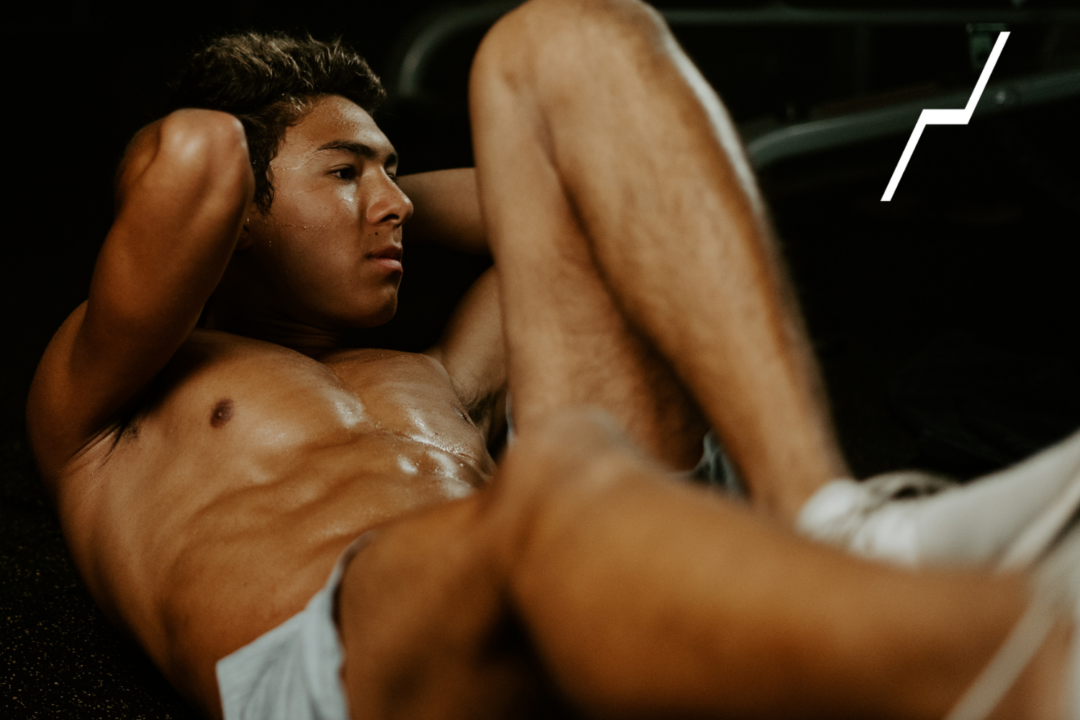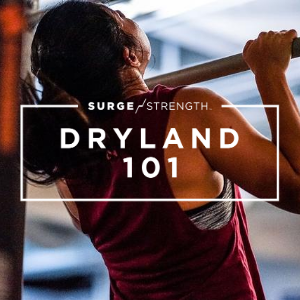During this COVID-19 season of life, many of us have felt our space collapse. Kitchen tables have become business operation centers, computers have become the center of social lives, and the small available space in the living room has become our weight room, dryland center, and stretching area. This creates yet another obstacle for coaches and swimmers to fully utilize their dryland results. But it doesn’t have to be this way. Here are 5 steps to creating a productive and exciting at home dryland workout:
At Home Dryland Workout Step 1: Create a Workout Space
While having a home gym is ideal, it is not necessary to have a productive dryland program. However, we do recommend having some essential equipment to maximize your results. Typically, bodyweight workouts consist mostly of pushing and squatting movements. However, it is important that your program is balanced with hinging, pulling, and bracing movements as well. Hinging and pulling are nearly impossible to do without any external resistance. In turn, we recommend having at least a few inexpensive items to incorporate into your dryland plan in order to keep your exercise ratios in check.
Our top 3 equipment recommendations are:
- A pull-up bar
- Kettlebell (8-12kg women/16-24kg men)
- Resistance band
If you have the means to invest in more at-home equipment, we suggest also having a few of the following equipment items:
- Mini-bands
- A sandbag (can be filled heavier or made lighter)
- A TRX or suspension training system
If you can’t access any workout equipment, you can still find external resistance in household objects. Towels, stairs, chairs, balls, weighted book-bags and other heavy objects are fun and creative tools that can be used to load dryland exercises.
At Home Dryland Work Step 2: Look at the Big Picture
First, recognize where you are in your season. Are you in-season or out-of-season? Maybe a mixture of both given the uncertainty of COVID restrictions. Plan accordingly. If you are still swimming, you will only need dryland 2-3 times per week. If at home dryland is your only option for training, consider a more extensive dryland plan. A common myth is that dryland can sabotage a taper or upcoming meet. However, this couldn’t be further from the truth. Instead, it keeps your nervous system primed and your body ready for competition.
At Home Dryland Workout Step 3: Make FITT Goals
Goals are what will keep you going, even when that living room dryland session doesn’t sound as appealing as it did on day 1. To increase their effectiveness, we recommend making FITT goals. FITT stands for Frequency, Intensity, Time, and Type.
Frequency
First, decide how many sessions of dryland you need per week (frequency). Again, this depends on how much training you are able to do in the pool and what your goals are for the season. For in-season athletes still swimming regularly, 2-3 sessions per week is ideal. For off-season swimmers or swimmers who are uncertain of their chances to swim this season, we recommend doing dryland workouts at least 4-5 days per week.
Intensity
Next, determine the Intensity of your sessions. For swimmers in-season, or approaching a meet, dryland intensity is lower than in the offseason, especially if you are still practicing in the pool. In this case, prioritize function exercises such as shoulder pre-hab, mobility, and core bracing movements. Avoid high intensity interval training (HIIT) that wears the body down. Instead, focus on primarily strength and power. For athletes whose seasons have been canceled due to COVID, you have an excellent opportunity to use this time to build strength and power with an off-season phase. We recommend training harder at home than you usually would at the gym this time of year.
Time
The Time dedicated to dryland varies greatly on the intensity of your program as well as what your goals are. We recommend carving out 30 minutes to an hour per dryland session. Keep in mind that your workout will move faster at home. This is because there is less transition time moving through equipment and less explanations before each segment from a coach. We suggest keeping training under 90 minutes to avoid giving athletes the feeling of burnt out or overtrain.
Type
The Type of training is up to you. In most cases, something is better than nothing. If you are swimming, focus on strength training. If dryland is your only activity at this time, energy-based sessions including rowing, biking, running, or HIIT are also beneficial when implemented appropriately.
At Home Dryland Workout Step 4: Choose the “Right” Exercises
Okay, we want to fix a mindset myth here: there is no such thing as right or wrong exercises. However, there are some exercises that will serve you better than others. It’s overwhelming to both the coach and the swimmer to choose just a few exercises to train at random. So, we break these key movements up into 5 categories: push, pull, hinge, brace, and squat.
There are endless ways to train these 5 movement categories. It depends on what equipment you have as well as what you specifically looking to train with each exercise. For example, are you primarily looking to increase power with squats or improve strength? If you are working on power, opt for a jump squat. To gain strength, try a loaded goblet squat instead. Our most recent article breaks down a few of our favorite bodyweight and minimal equipment exercises specifically for at-home training. Keep your training between the 5 movement categories even, and remember that we all have a tendency to go heavy on squatting and pushing.
At Home Dryland Workout Step 5: Put Your Plan into Action
Be consistent. The plan is only as good as your dedication to it. Working out at home can be challenging to start. There’s the temptation of sitting on the couch and watching tv instead of getting down and doing your exercises. This is why we suggest scheduling a workout into your day. It is also wise to dedicate a space in (or outside) of your home for your workouts separate from where you relax if at all possible. It’s much less tempting to kick up your feet and push off the rest of your workout in your garage than in your living room.
Regardless of your situation, hold yourself accountable to your dryland plan. The dropout rate for any fitness program is 50%. This rate decreases dramatically when you have a friend commit to the dryland plan with you, so that you can do it together. Coaches, this is a great time for a zoom dryland option or a shared workout plan for the entire team. Athletes training alone, consider working with one of our Dryland Certified Coaches to create a custom dryland program for your goals.
An all-or-nothing approach is never the answer, especially during these unprecedented times. Equipment or not, follow the 5 steps laid out above to create an essential at-home dryland approach. And you can always go more in-depth in this and other dryland topics when you enroll to become SURGE Strength Dryland Certified (SSDC).
NEW – At Home Dryland Workout
Get it for FREE by Enrolling in the SURGE Strength Academy
BECOME SURGE STRENGTH DRYLAND CERTIFIED (SSDC)
BUILD BETTER ATHLETES TO GENERATE FASTER SWIMMERS
Courtesy of SwimSwam’s exclusive dryland training partner, SURGE Strength.
SURGE Strength, a strength training brand created by Chris Ritter, CEO of RITTER Sports Performance, aims to build better athletes and faster swimmers through dryland programs, and coaching education.







